Cabbage is a highly nutritious cruciferous vegetable often left in abundance during certain seasons or after making dishes like coleslaw or sauerkraut. You might find yourself with more cabbage than you know what to do with, but there’s a wealth of options to prevent waste and expand your culinary repertoire. Packed with vitamins, minerals, and fiber, the versatility of cabbage makes it an excellent ingredient for a variety of dishes.
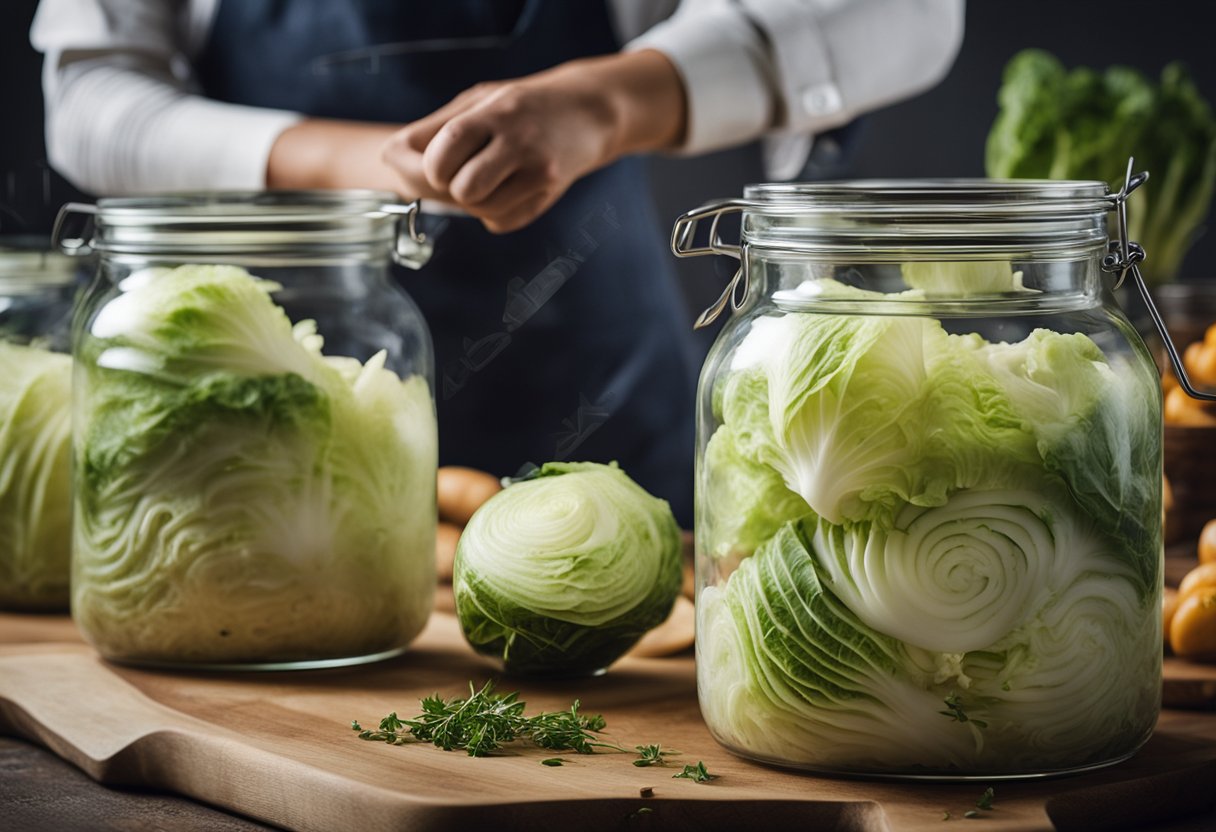
With its crisp texture and subtle flavor, cabbage can easily be incorporated into your daily meals in many forms. You can use it raw in salads, ferment it into kimchi or sauerkraut, stuff it with a mixture of ground meats and grains, or simply sauté it as a flavorful side dish. Beyond these traditional uses, cabbage is a staple in many international cuisines, meaning that you have a world of recipes to explore.
When dealing with extra cabbage, consider its shelf life and storage. When stored correctly in a cool, dry place, whole heads of cabbage can last for weeks, extending out the time you have to use it up. If you have already cut your cabbage, it will stay fresh in the refrigerator for a few days. Quick-pickling is another method to extend its shelf life while adding a zesty flavor. This approach not only saves your excess cabbage from being discarded but also provides you with a tangy condiment or snack for future use.
Preparing Cabbage for Various Dishes
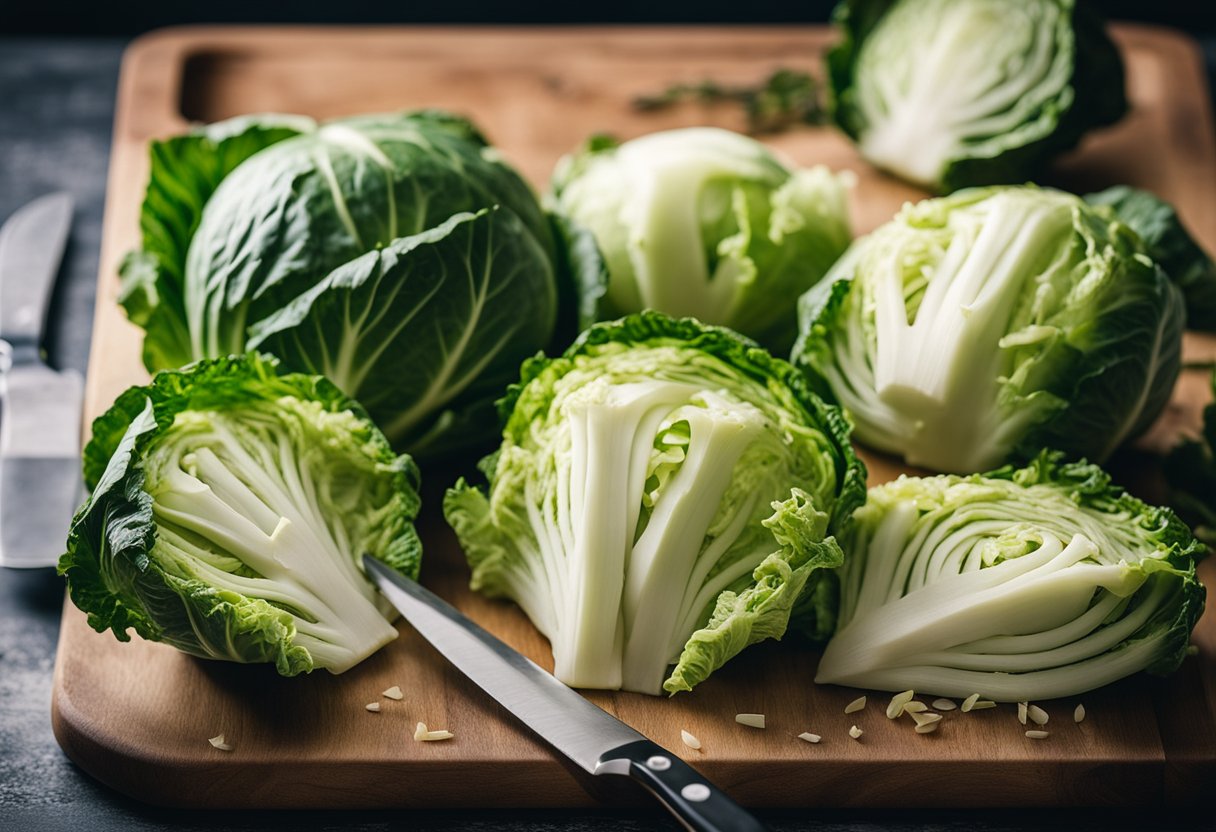
Before incorporating cabbage into your meals, proper preparation is crucial for safety and to enhance the dish’s quality. Efficient washing and chopping techniques ensure optimal texture and flavor, while adhering to safety tips for storing and preserving cabbage maximizes freshness and longevity.
Washing and Chopping Techniques
- Washing:
- Remove Outer Leaves: Discard any wilted or discolored outer leaves.
- Rinse Thoroughly: Run cold water over the remaining cabbage to wash away dirt and potential contaminants. You may use a vegetable brush for a more thorough cleaning.
- Drain and Pat Dry: Shake off excess water and use paper towels or a clean cloth to pat the cabbage dry.
- Chopping:
- Remove Core: Slice the cabbage into quarters and cut away the hard central core from each piece.
- Slice or Shred: Depending on your recipe, you can slice the cabbage into wedges for roasting or shred it finely for salads and slaws.
- Seasoning Prep: To enhance flavor, prep your cabbage with salt or other seasonings; salt can help in drawing out the water and making the cabbage more pliable, while vinegar can add a tangy note.
Safety Tips for Storing and Preserving Cabbage
- Storage:
- Refrigeration: Store your prepped cabbage in the fridge to preserve its texture and color.
- Containers: Use airtight containers or resealable plastic bags to minimize exposure to air.
- Preservation:
- Salt and Vinegar: These are natural preservatives that can help maintain the quality of your chopped cabbage.
- Freezing: Blanch chopped cabbage before freezing to preserve its texture and flavor for future cooking.
Remember, attention to these details can significantly influence the success of your cabbage dishes. Keeping these points in mind will help ensure that your meals are both delicious and safe to enjoy.
Delicious Cabbage Recipes
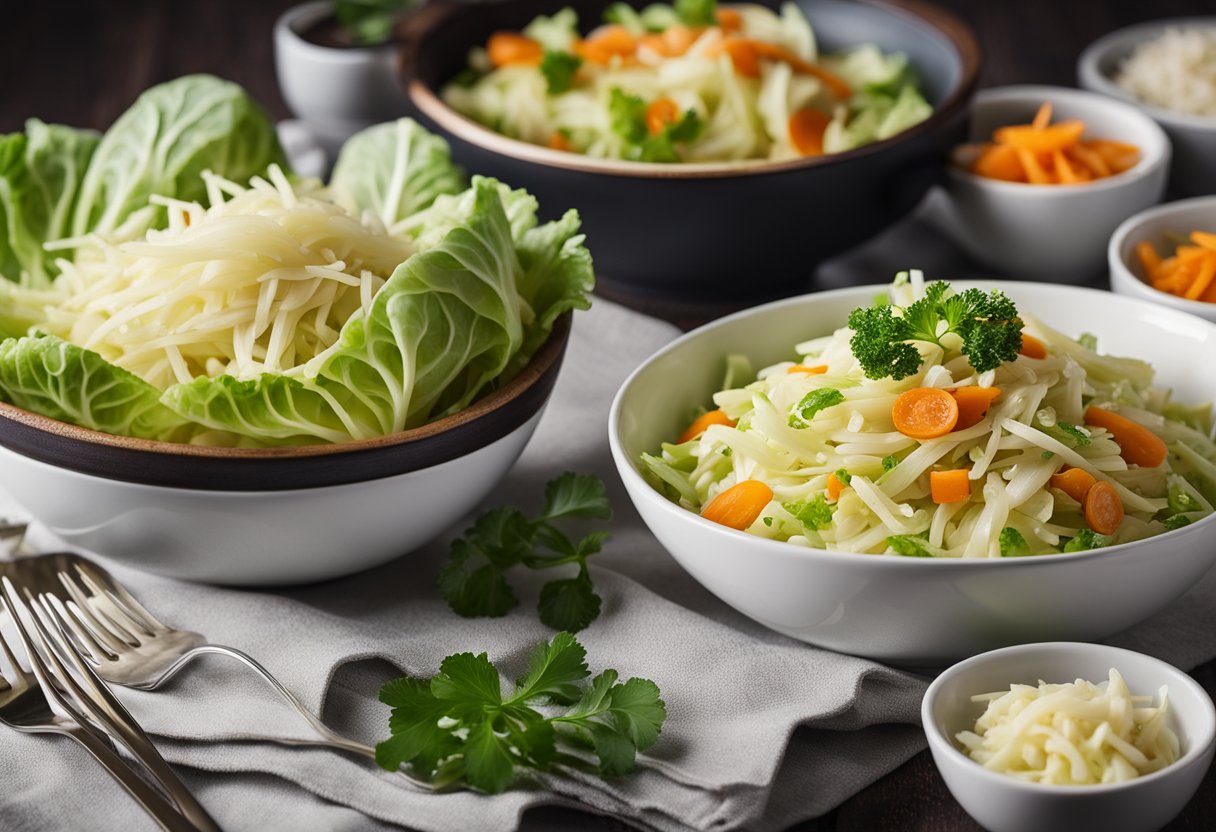
Cabbage, a versatile leafy green, offers endless culinary possibilities. From hearty soups to vibrant salads and international dishes, explore the flavors cabbage brings to the table.
Classic Cabbage Soup
Your comfort food collection will be incomplete without a simple yet savory cabbage soup. Begin with sautéing onions, carrots, and celery, then add chopped cabbage and cook until slightly tender. Pour in chicken or vegetable broth, season with salt, pepper, and herbs, and simmer until all vegetables are cooked. For added protein, consider including shredded chicken or beans. Serve hot for a nourishing meal that’s perfect on a chilly day.
Versatile Cabbage Salads
For a quick and healthy meal, cabbage salads offer variety and crunch. Classic coleslaw, mixing shredded cabbage and carrots with a mayonnaise or vinegar-based dressing, is ideal for picnics. Take it further by tossing red cabbage with vinaigrette, green onions, and roasted nuts to create a colorful and tangy side dish.
- Quick Coleslaw:
- Shredded green cabbage
- Carrots
- Mayonnaise or vinegar
- Salt and pepper to taste
Main Course Cabbage Delights
Cabbage transforms into a satisfying main course with dishes like stuffed cabbage rolls and roasted cabbage. Combine ground meat, rice, and herbs, wrap them in blanched cabbage leaves, and bake with tomato sauce for a classic stuffed roll. Or slice cabbage into thick wedges, drizzle with oil, season, and roast until edges are crispy for an easy side dish.
- Stuffed Cabbage Rolls:
- Ground beef or pork
- Cooked rice
- Tomato sauce
- Garlic and onion for flavor
International Cabbage Inspirations
Travel the world with international cabbage recipes right from your kitchen. Try your hand at cabbage tacos, folding sautéed or pickled cabbage into warm tortillas with your favorite protein. Experiment with German flavors by preparing sauerkraut, fermenting shredded cabbage to serve alongside dishes like corned beef. Or, create a comforting bowl of Haluski, a simple Eastern European dish of fried cabbage and noodles.
- Sauerkraut:
- Thinly sliced cabbage
- Kosher salt
- Caraway seeds (optional)
- Time for fermentation
Commit these recipes to your cooking repertoire and make the most of every cabbage head, whether fresh from the market or discovered in the back of your refrigerator.
Pairing Cabbage with Other Ingredients
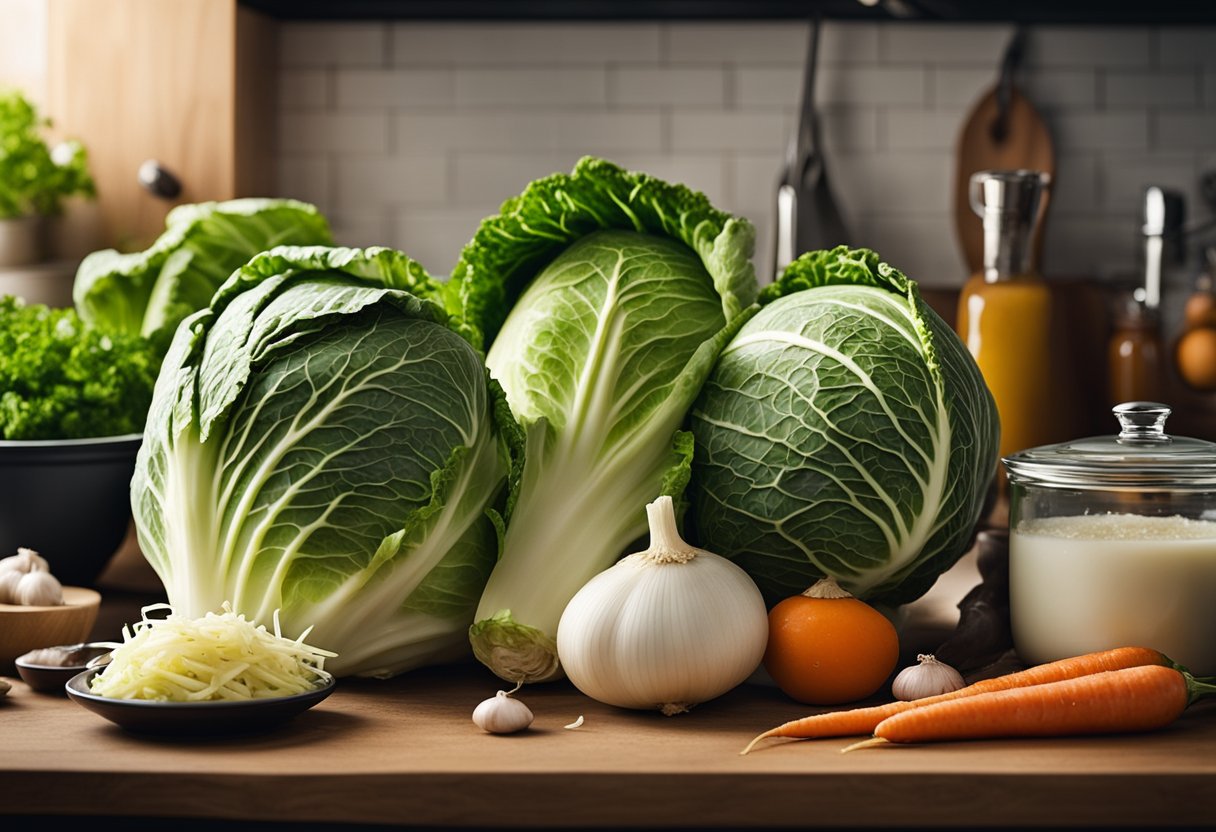
When you have extra cabbage, pairing it with complimentary ingredients can elevate this versatile vegetable into a delightful dish.
Combining Cabbage with Proteins
Cabbage pairs exceptionally well with a variety of proteins. For a classic dish, you might cook corned beef with green cabbage, infusing a hearty flavor. Consider preparing cabbage with bacon or bacon drippings for a rich, smoky taste. Ground beef or pork, when added to cabbage, can form the basis of comfort food such as stuffed cabbage rolls or cabbage soup. Additionally, cabbage complements the delicate flavor of lamb, which can be accentuated when cooked with buttery cabbage.
| Protein | Preparation Idea |
|---|---|
| Bacon | Sauté with shredded cabbage |
| Corned Beef | Serve with wedges of cabbage |
| Ground Beef | Mix into cabbage casserole |
| Pork | Incorporate with cabbage stir-fry |
| Lamb | Braise cabbage with lamb chunks |
Cabbage and Vegetable Harmonies
You can create subdued or vibrant dishes by harmonizing cabbage with other vegetables. Carrots, onions, and tomatoes add sweetness and depth to cabbage dishes, while green beans and peppers can introduce a refreshing crunch. For a starchy component, mix potatoes with cabbage to create a filling meal. These combined vegetables can work well in dishes ranging from stir-fries to cozy stews.
- Carrots add a hint of sweetness.
- Potatoes provide heartiness and are ideal for a robust meal.
- Peppers introduce a mild or spicy note, depending on variety.
- Green Beans offer a crisp texture contrast.
- Onions deliver a base flavor that complements the natural taste of cabbage.
Enhancing Cabbage with Herbs and Spices
The natural flavor of cabbage can be significantly enhanced by the judicious use of herbs and spices. For example, creole seasoning can introduce a spicy palette to a cabbage dish, making it lively and flavorful. Curry spices bring a delcious flair to cabbage dishes, pairing exceptionally well with potatoes and beef. A touch of sugar or honey balances cabbage’s bitterness, while soy sauce adds a salty, umami quality. Don’t shy away from using fresh herbs, such as dill or parsley, to add a brightness that complements the cabbage’s earthiness. A dollop of sour cream on top of your seasoned dish can smooth out the flavors for a rich, comforting finale.
- Creole Seasoning: Perfect for a spicy kick.
- Curry: Brings warmth and depth, especially with potatoes.
- Honey/Sugar: Mix in to reduce bitterness.
- Soy Sauce: Adds depth and an Asian twist to cabbage dishes.
- Sour Cream: Ideal for topping a spice-laden cabbage dish.
Creative Uses for Leftover Cabbage
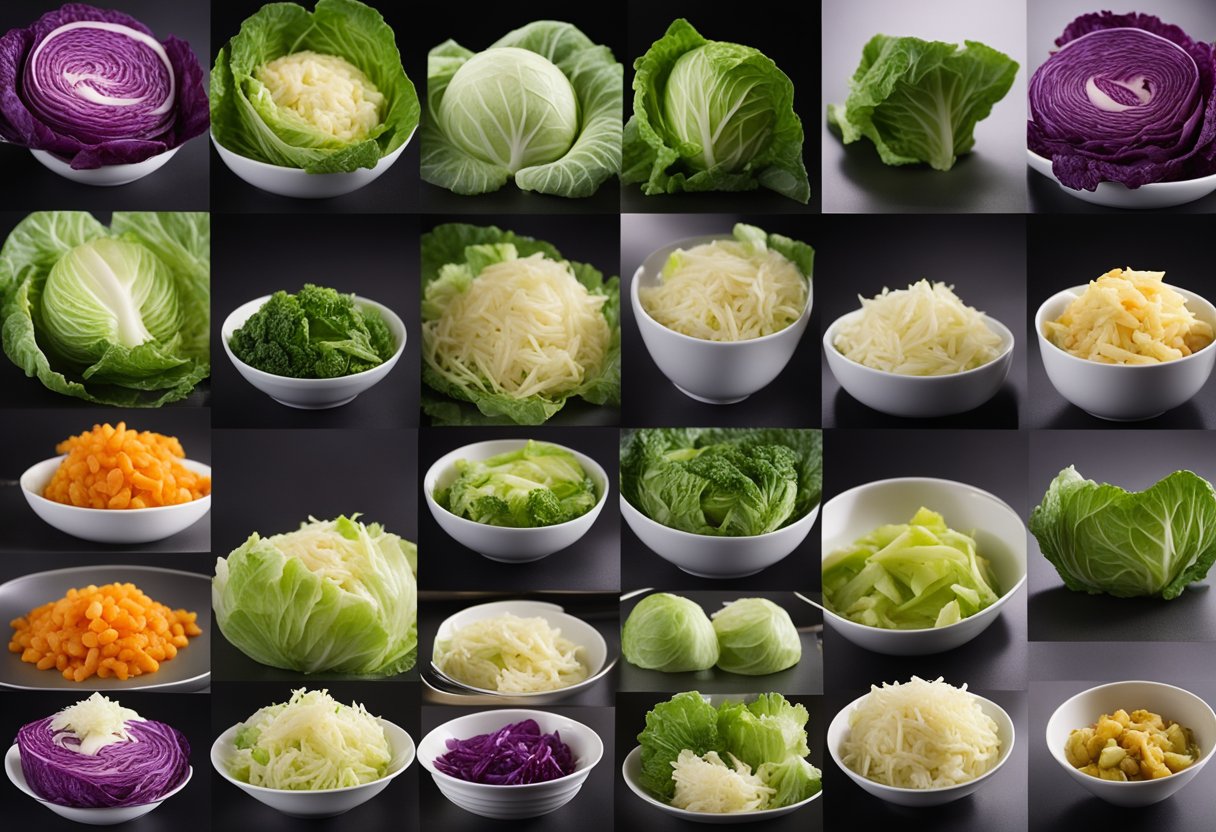
Leftover cabbage need not go to waste. Explore innovative ideas for repurposing your excess cabbage into delicious meals or learn how to preserve it efficiently for later use.
Innovative Ideas for Leftover Cabbage
Transform your cabbage into tangy sauerkraut. With just some salt and a bit of patience, you’ll turn that extra crunch into a probiotic-rich topping for sandwiches or side for meals. Incorporate garlic and other robust flavors to create a unique twist on this traditional dish.
Consider these meal options:
- Stuffed Cabbage Rolls: Use leftover cabbage leaves to wrap a hearty mixture of ground meat, rice, spices, and tomato sauce.
- Cabbage Stir-Fry: Add garlic, celery, broccoli, cauliflower, and kale to your shredded cabbage for a nutrient-packed stir-fry.
- Cabbage and Potato Hash: Combine chopped cabbage with mashed potatoes, onions, and seasoning for a loaded breakfast hash.
To aid in meal planning, leftover cabbage can easily be incorporated into your weekly menu as a nutritious addition to many dishes.
Preservation Techniques for Excess Cabbage
Freezing: Cabbage can be blanched and frozen to retain its nutrients and crunch. Use these steps:
- Chop the cabbage into wedges or shreds.
- Blanch in boiling water for two minutes.
- Quickly transfer to ice water to halt cooking.
- Drain and pack in containers or zip-lock bags and freeze.
Table of Cabbage Storage Life:
| State | Container | Shelf Life |
|---|---|---|
| Fresh, Refrigerated | Plastic bag | 1-2 weeks |
| Blanched, Frozen | Freezer-safe containers or bags | Up to 9 months |
Remember, always label your containers with the date to keep track of freshness. This will streamline your meal planning process and reduce food waste.
Frequently Asked Questions

In this section, you’ll find practical ways to use up your leftover cabbage, whether it’s fresh, boiled, or about to spoil, along with storage tips to extend its shelf life.
How can I use leftover boiled cabbage in new dishes?
You can repurpose boiled cabbage by incorporating it into potato mash, mixing it into casseroles, or using it as a nutritious addition to soups and stews.
What are some creative recipes for red cabbage?
Try making a tangy red cabbage slaw with a vinaigrette, braising it with apples for a sweet and sour side dish, or adding it to tacos for a colorful twist.
What are the best ways to incorporate cabbage into a stir fry?
For stir-fries, slice your cabbage thinly for quick cooking and pair it with flavorful ingredients like garlic, ginger, and soy sauce. It’s best added toward the end of the cooking process to retain some crunch.
Is it possible to freeze cabbage for later use?
Yes, you can freeze cabbage. Blanch chopped cabbage for two minutes, plunge it into cold water, drain well, and freeze it in airtight bags for up to nine months.
How can I prevent my cabbage from going bad?
To prevent cabbage from going bad, keep it dry and wrapped loosely in plastic in your refrigerator’s crisper drawer. Avoid washing or cutting it until you’re ready to use it.
How long can I store cabbage in the refrigerator?
Whole cabbage heads can last up to two weeks in the refrigerator, but once cut, use the cabbage within 3-5 days for optimal freshness.
